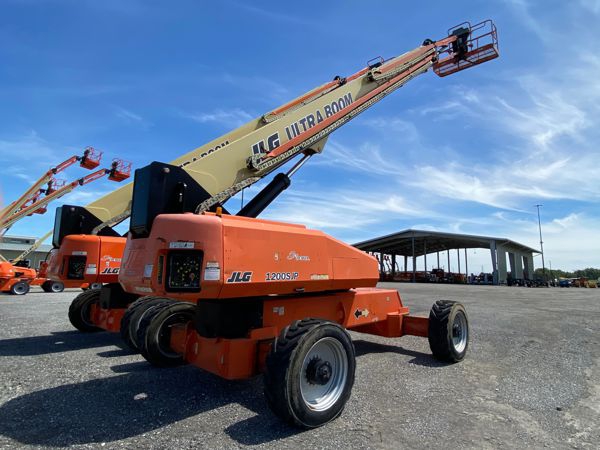
Aerial lifts are essential tools used to access elevated areas safely and efficiently. These versatile machines come in various forms, such as boom lifts, articulating boom lifts, scissor lifts, and telescopic boom lifts, each designed for specific tasks and environments.
In recent years, more contractors and construction sites have turned to aerial lifts over traditional scaffolding and ladders due to their superior mobility and ability to reach challenging spots. This shift has made aerial lifts a staple on modern job sites, offering both time and labor efficiency.
Leading manufacturers in the industry include JLG and Terex’s Genie, known for producing reliable and high-performance equipment that meets strict safety standards.
Like any heavy machinery, aerial lifts come with inherent risks if not operated properly. Common hazards include falls from the platform, objects falling from above, tip-overs, ejections, structural failures, electrocution near power lines, and entanglement. These dangers emphasize the importance of proper training and adherence to safety protocols.
OSHA provides detailed guidelines to ensure safe use of aerial lifts on job sites, covering everything from pre-operation checks to operational procedures and emergency responses.
Pre-Lift Inspection
Before every work shift, it's crucial to conduct a thorough inspection of your aerial lift. Check the following components to ensure everything is functioning correctly and ready for use:
-
Vehicle Components:
- Check fluid levels (oil, hydraulic, fuel, and coolant).
- Look for signs of leaks.
- Inspect wheels and tires for wear or damage.
- Verify battery and charger functionality.
- Test lower-level controls.
- Ensure all lights, gauges, horn, and backup alarms are working.
- Confirm steering and braking systems are in good condition.
-
Lift Components:
- Check operating and emergency controls.
- Ensure personal protective equipment (PPE) is available and in good shape.
- Inspect hydraulic, air, pneumatic, fuel, and electrical systems.
- Examine fiberglass and insulating parts for damage.
- Make sure all warning labels and markings are readable.
- Check mechanical fasteners, locking pins, cables, and wiring.
- Inspect outriggers, stabilizers, and other structural elements.
- Look for missing or loose parts.
- Confirm guardrail systems are intact.
-
Work Zone Inspections:
- Identify drop-offs, holes, or unstable ground.
- Check for adequate ceiling height.
- Watch out for slopes, ditches, or bumps.
- Clear the area of debris and obstacles.
- Be aware of overhead power lines and communication cables.
- Monitor weather conditions like high winds or ice.
- Ensure no one is too close to the work zone.
Safety Practices When Operating An Aerial Lift
Fall Protection
- Always keep access gates and openings closed.
- Stand firmly on the platform floor with both feet.
- Never climb on or lean over guardrails.
- Avoid using planks, ladders, or other makeshift tools inside the platform.
- Use a body harness or restraining belt with a lanyard attached to the boom or bucket.
- Never tie yourself off to structures or poles while in the bucket—this can lead to serious injury if the platform moves unexpectedly.
Operation/Traveling/Loading
- Never exceed the load capacity of the lift. Consider the combined weight of workers, tools, and materials.
- Do not use the aerial lift as a crane. It is not designed for lifting heavy loads and could cause damage or injury.
- Avoid carrying items larger than the platform’s size.
- Do not drive with the platform raised unless specifically permitted by the manufacturer.
- Only operate lower-level controls if authorized by the worker(s) in the lift, except in emergencies.
- Stay within the lift’s vertical and horizontal reach limits.
- Avoid operating in high winds that exceed the manufacturer’s recommendations.
- Never override safety devices such as hydraulic, mechanical, or electrical systems.
Overhead Protection
- Be mindful of overhead clearance and potential obstructions.
- Avoid positioning the lift between overhead hazards when possible.
- Treat all overhead power lines and cables as live. Maintain a minimum distance of 10 feet.
- Ensure utility workers de-energize power lines in the work area before starting operations.
Aerial Lift Stability
- Extend outriggers on solid, level surfaces or pads.
- Engage brakes when using outriggers.
- Use wheel chocks on sloped surfaces when safe to do so.
- Set up warning signs or cones to alert others in the work zone.
Group Discussion Topics
- Is the aerial lift in good condition? Perform a daily visual check for tire pressure, hydraulic lines, and signage.
- Are there any nearby hazards at elevated levels, such as power lines or gas pipes?
- What is the condition of the ground where the lift will be operated? Is it stable and level?
- How many people will be on the platform? Does the total weight stay within the lift’s limit?
- What factors might cause the lift to tip over? How can this be prevented?
Find Similar Articles By Topic
#construction #material handling #toolbox talks #aerial lifts #Terex #JLG
Backhoe Loaders,Backhoe Tractors,Backhoe Loaders Machines,Backhoe Loaders Construction
Shandong Davoo Machinery Co., Ltd. , https://www.sddigger.com
![<?echo $_SERVER['SERVER_NAME'];?>](/template/twentyseventeen/skin/images/header.jpg)